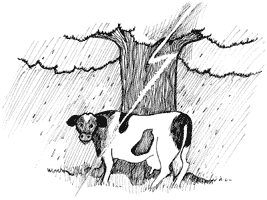>> Back to The HooK front page
STRANGE BUT TRUE- Milk shake: Too bad cow can't squat
Published April 14, 2005 in issue 0415 of the Hook
BY BILL SONES AND RICH SONES, PH.D.

DRAWING BY DEBORAH DERR McCLINTOCK
Q. A cow takes shelter under a large tree during a thunderstorm. To minimize chances of injury in case of a lightning strike to the tree, she should stand a) facing toward the trunk b) facing away c) sideways to the tree. --B. Franklin
A. c. Lightning hitting a tree sends ground currents radiating outward from the trunk, says Jearl Walker in The Flying Circus of Physics. A cow facing toward or away from the trunk will have its front and hind legs at different distances from the tree, creating an electrical "potential" from nose to tail, so the electricity would enter through one pair of legs and go out the other. Zap!
Better to stand sideways to the trunk, if not far away.
An unprotected person shouldn't stand or lie down, which would be like the cow's predicament, but rather squat with feet together, keeping head low and minimizing ground contact.
Q. In the German Lotto on June 21, 1995, the numbers 15-25-27-30-42-48 were drawn out of 49. Bizarrely, it was later discovered that these same 6 had been drawn on December 20, 1986, something that hadn't happened before in the 3,016 drawings of the Lotto. With nearly 14 million combos possible, how incredible was this really? Was someone rigging the picks? --L. Luck
A. Pardon the daunting math, but to figure the likelihood of getting a match in 3,016 drawings, first you need to figure the likelihood of getting no matches, says Henk Tijms in Understanding Probability.
Start by multiplying 13,983,816 x (13,983,816 - 1) x (13,983,816 - 2)... x (13,983,816 - 3,015). There are 3,016 factors here. Then divide by 13,983,816 to the 3016 power! Once your overworked computer cools off, you'll see an answer of 0.7224. But that's the likelihood of no matches; instead subtract 1 - 0.7224 to find the likelihood of at least one match, which equals 0.2776. This means there was a better than 1 in 4 chance that this would happen in 3,016 drawings!
What fools people is that the chance of matching a particular 6-number-sequence is vanishingly small, but not the chance of matching SOME 6-number-sequence along the way. Says Tijms: This is basically another version of the classic birthday paradox, where all it takes is 23 people in a room for there to be a 50-50 chance of at least two of them having the same birthday.
"In the lottery situation, it's analogous to there being 3,016 people in the room and 13,983,816 possible birthdays."
So no rigging necessary, but just someone's incredible record-keeping to track thousands of picks and spot the repeat.
Q. Is there such a thing as an "average man" or an "average woman"? --A. Joe
A. The term was coined by Belgian scientist Adolphe Quetelet in the 1830s when he realized that measurements of heights and chest circumferences of French and Scottish soldiers followed a "normal distribution," the classic bell- shaped curve, say Jeffrey Bennett and William Briggs in Using and Understanding Mathematics.
Fundamentally, any quantity that is the result of many factors is likely to follow such a distribution, as with adult heights (resulting from many genetic and environmental factors), chest sizes, shoe sizes, I.Q.s, S.A.T. scores, and on and on. While there's an average man/woman on each of these, there is no average man or woman on all of them.
Q. An exceptionally beautiful quarter horse eats a banana, goes into uncontrollable muscle spasms and paralysis, suffers irregular heartbeat and obstructed airways, then topples over and dies. What was wrong with the horse? --M. Boyle
A. It had a defective gene-- the same one responsible for its beautiful musculature-- giving it "hyperkalemic periodic paralysis," says Sharon Bertsch McGrayne in 365 Surprising Scientific Facts, Breakthroughs, and Discoveries. Tens of thousands of quarter horses in the U.S. have this, affecting their ability to metabolize potassium-rich foods like alfalfa and bananas. Evidence suggests they all inherited the gene from one particular stallion used as a stud in the 1970s and 1980s.
Tests can be done to identify the gene, so it could be eliminated in a single generation. Breeders, however, may not want to get rid of the gene, which many believe add to the beauty of the horses, raised as much for show as for racing. "Alternatively, the disease can be controlled via diet and diuretics."
Send Strange questions to brothers Bill and Rich at .
#
>> Back to The HooK front page
|